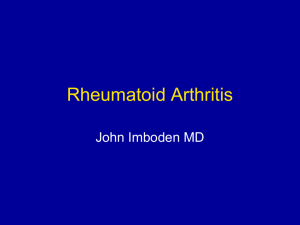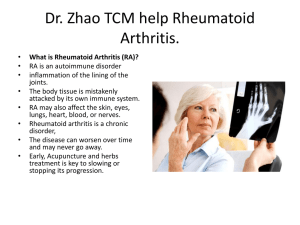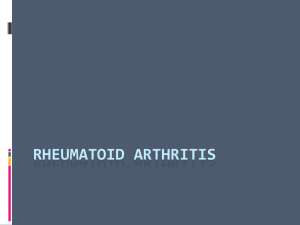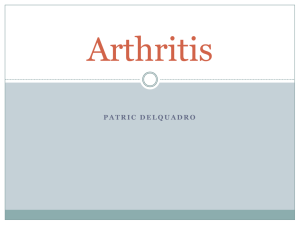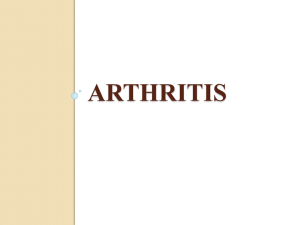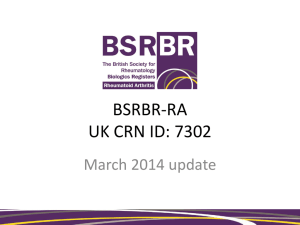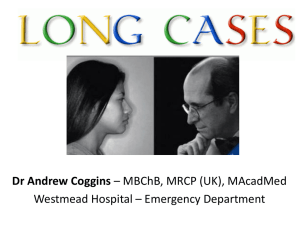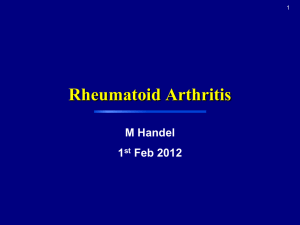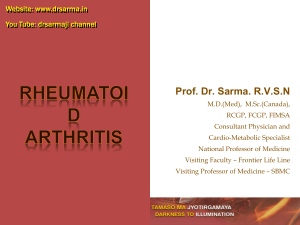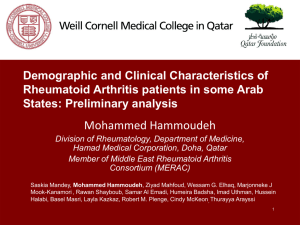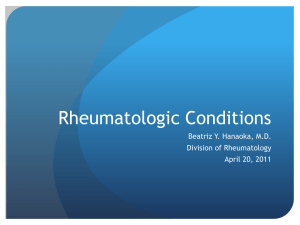Rheumatoid Arthritis
advertisement
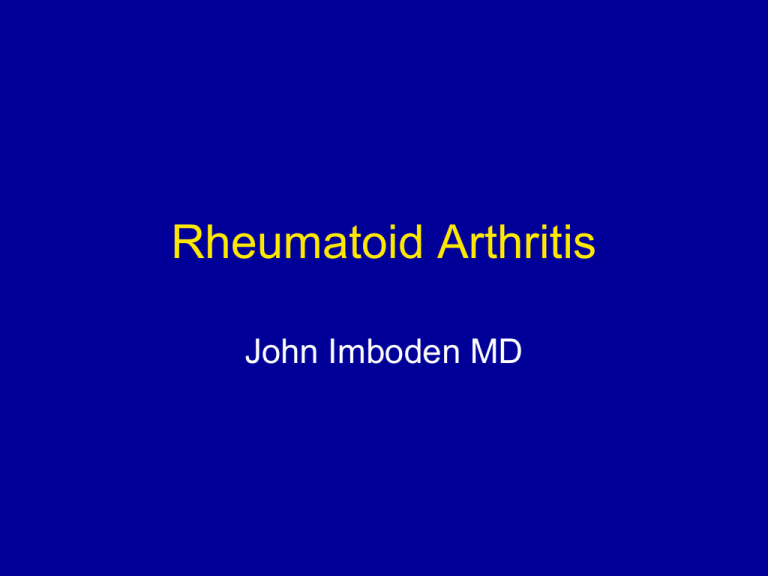
Rheumatoid Arthritis John Imboden MD Rheumatoid arthritis: typical presentation • Prevalence 1% • Female > male (3:1) • Peak onset: age 30s to 40s • Insidious onset of joint pain & AM stiffness lasting hours • Swelling of wrists and small joints of the hands The natural history of rheumatoid arthritis at presentation after 5 years after 15 years - Chronic disease - Progressive damage leading to joint deformity & disability - Extra-articular disease: nodules, lung, eye, vasculitis, etc - Diminished life expectancy Rheumatoid Arthritis • Polyarthritis of synovial lined joints – Characteristic pattern of joint involvement • Inflammatory arthritis – autoimmune • Destructive arthritis – Cartilage degradation – Erosion of bone adjacent to joints – Joint deformities • Systemic disease Rheumatoid Arthritis: pathogenesis • Etiology uncertain • Autoimmune disease – Characteristic autoantibodies • Genetic predisposition • Mechanisms of joint damage Rheumatoid Arthritis: autoantibodies • Rheumatoid factor – Autoantibody to Fc region of IgG – Occur in c. 70% of RA patients – Despite the name, not specific for RA • Antibodies to citrullinated protein epitopes – Occur in c. 70% of RA patients – Highly specific for RA – May be pathogenic Posttranslational modification of proteins: PAD converts arginine to citrulline Peptidylarginine deiminase (PAD) RA-associated autoantibodies recognize protein epitopes containing citrulline Peptide sequence ESSRDGSRHPRSHD Antibody recognition No PAD ESSRDGScitHPRSHD Yes Protein Citrullination • Constitutive citrullination of proteins in skin and elsewhere – Physiological roles of citrullination are diverse and incompletely understood • Citrullination of proteins occurs in inflamed joints in many forms of arthritis – NOT specific for RA • Loss of tolerance to citrullinated proteins is specific for RA Antibodies to Citrullinated Protein Epitopes • Detected using synthetic cyclic citrullinated peptides – “anti-CCP antibodies” • Anti-CCP positive RA: – Genetically distinct form of RA – More aggressive arthritis RA: genetic susceptibility • Heritability 60% • Multiple genes involved • Most important: HLA-DRB1 – Encodes b chain of a MHC class II antigen – Linked to “CCP-positive” RA Environmental event(s) Genetic predisposition Loss of tolerance to self antigens Preclinical autoimmunity Clinically apparent joint inflammation (synovitis) Synovial inflammation in RA Synovial inflammation in RA normal joint rheumatoid joint Synovitis: - proliferation of synovial lining cells - influx of mononuclear cells - angiogenesis Pannus: - the component of the inflamed synovium that invades cartilage and bone Joint effusion: - influx of neutrophils into synovial fluid Joint inflammation in RA Rheumatoid wrist Inflammation within bone Normal wrist synovial inflammation 3 Tesla MRI provided by Xiaojuan Li PhD Cytokine production in rheumatoid synovium • Large number of cytokines produced • Macrophage-derived cytokines: – Proinflammatory cytokines: TNF-a, IL-1, IL-6 – Dominant cytokines in quantitative terms • T cell cytokines: – Interleukin-17 > interferon-g (Th17 cells may be more important than Th1) Mechanisms of joint inflammation and destruction in RA: conclusions from trials with selective inhibitors Target Response Clinical Joint damage T cell co-stimulation B cell ++ ++ ++ Proinflammatory cytokines tumor necrosis factor interleukin-1 interleukin-6 ++ + ++ ++ + ++ ++ Roles of TNF and IL-1 in cartilage degradation and erosion of bone Induce chondrocytes and fibroblasts to produce matrix metalloproteinases and other proteases that degrade cartilage Together with RANK-RANKL interactions, promote differentiation of precursors cartilage into osteoclasts, which are bone the destructive element where the pannus invades bone RA: clinical presentation • Onset: usually insidious – Patients typically present after weeks to months of symptoms • Articular symptoms dominate • Constitutional symptoms – Common: fatigue, low grade fever (<38°C) – Uncommon: extensive weight loss, fever > 38°C RA: articular symptoms RA is an inflammatory arthritis: – Morning stiffness • Often lasts hours • Can be the dominant symptom – Joint pain and stiffness improve with activity – “gel phenomenon” • Stiffness recurs after prolonged inactivity RA: joint involvement • Symmetric – e.g., both wrists, both knees • Additive • Polyarthritis (>5 joints involved) • Arthritis, not just arthralgias – Involved joints: tender and swollen – Larger joints: warm, effusions • Not erythematous RA: pattern of joint involvement • Hands (involved in >90%) – Wrists, metacarpophalangeal (MCP) & proximal interphalangeal (PIP) joints – Spares distal interphalangeal (DIP) joints • Axial skeleton – Cervical spine can be involved – Spares thoracic, lumbosacral spine, SI joints • Large joints • Feet Early RA with fusiform swelling of the 3rd and 4th PIP joints Rheumatoid arthritis: irreversible damage can occur early in disease course 1 year prior to onset of RA 6 months after onset of symptoms 3 years after onset of symptoms Radiographic changes in the same joint over time Radiographic changes occur early and precede joint deformities by years (adapted from Wolfe & Sharp, Arth Rheum 41: 1571, 1998) count scale Arbitrary 20 15 joint narrowing 10 joint erosions 5 0 0 10 years 20 joint deformities Characteristic joint deformities in RA “Swan neck” deformities: hyperextension of PIPs and flexion of DIPs “Boutonniere” deformity: flexion of PIP and hyperextension of DIP Characteristic joint deformities in RA Ulnar deviation of the fingers Volar subluxation of MCPs Rheumatoid nodules Note the symmetry of the joint involvement Characteristic joint deformities in RA Subluxation of the metatarsals as a consequence of MTP arthritis RA: extraarticular manifestations • Common: – – – – Rheumatoid nodules Sicca (Sjögren) syndrome Interstitial lung disease Ocular inflammation: Scleritis and episcleritis • Uncommon: – Vasculitis – Clinically apparent pleuritis or pericarditis – Felty syndrome (RA, splenomegaly, neutropenia) Rheumatoid nodule RA: Laboratory findings • Routine laboratory: – Mild to moderate anemia – Mild to moderate thrombocytosis • High erythrocyte sedimentation rate or elevated C-reactive protein • Synovial fluid analysis – Inflammatory – WBC counts usually in 5,000 – 50,000 range – Neutrophil predominance RA: Autoantibodies • Anti-CCP Antibodies – High specificity – Identifies patients with more aggressive joint disease • Rheumatoid factor – Limited specificity – Patients who develop extra-articular disease are almost always “sero-positive” for RF Diagnosis of RA • Clinical diagnosis • Key feature: inflammatory polyarthritis affecting proximal joints of the hands • Compatible laboratory data, serologies, and radiographs • Exclusion of other causes of inflammatory polyarthritis Diagnosis: some mimics of RA • Acute viral infections: self-limited polyarthritis – Acute parvovirus B19 infection in adults • Chronic hepatitis C infection – RF-positive non-erosive chronic polyarthrtis • Systemic lupus and other systemic rheumatic diseases • Spondyloarthropathies • Primary osteoarthritis of the hands • Systemic vasculitis Goals of therapy for RA • Reduce signs and symptoms of inflammation • Prevent joint deformities Treatments for RA • Nonsteroidal anti-inflammatory drugs – Aspirin 1890s • Low dose glucocorticoids – Early 1950s • Disease-modifying antirheumatic drugs (DMARDs) – Methotrexate mid-1980s • Biological agents – Anti-TNF agents late 1990s Raoul Dufy “La Cortisone” 1951 Methotrexate: most commonly used DMARD • Mainstay of treatment for RA – reduces signs and symptoms in majority – slows radiographic progression • Works slowly (weeks) • Uncertain mechanism of action in RA Biological agents for RA • Monoclonal antibodies, receptor/antibody chimeras • Targets: – – – – Tumor necrosis factor (TNF) T cell-costimulation B-cells IL-6 receptor • Parenteral administration (SQ or IV) • Toxicity (infection, ?malignancy) • $$$ Anti-TNF therapy of RA • Reduces signs and symptoms for patients with active disease despite methotrexate • Combination of anti-TNF and methotrexate: – superior to either agent alone for reducing disease activity – prevents radiographic progression for most patients, at least for 1-2 years • Not all patients respond, and many responses are incomplete Treatment of RA: general principles • Patients should be started on effective therapy (eg, a DMARD) within 3 months of diagnosis • Combination therapy appears more effective than monotherapy • Goal is remission or “mild” activity by standardized assessments • There are few head-to-head comparisons to guide therapeutic decisions A therapeutic approach to new onset RA • Start prednisone 5 mg/day – Acts quickly, joint-protective • Start methotrexate – Initiate long term therapy with an agent shown to retard radiographic progression • If disease still active despite optimal methotrexate, add an anti-TNF agent – Alternative: start with methotrexate plus anti-TNF • If disease refractory to anti-TNF, switch to another biological agent Rheumatoid arthritis: 2010 • Treatable, but not curable – Therapies can slow or even prevent joint damage • Early RA is a therapeutic opportunity – Clinical remission achieved in 50% • Most treated RA patients have residual mild to moderate activity • 10-20% have refractory disease Rheumatoid arthritis: key points • Pathogenesis – Genetic predisposition – Anti-CCP antibodies – Connection between proinflammatory cytokines and joint destruction • Clinical course of RA: descriptors of common joint deformities, extraarticular manifestations • Distinguish RA from osteoarthritis, spondyloarthropathies, and lupus • Major classes of therapies
